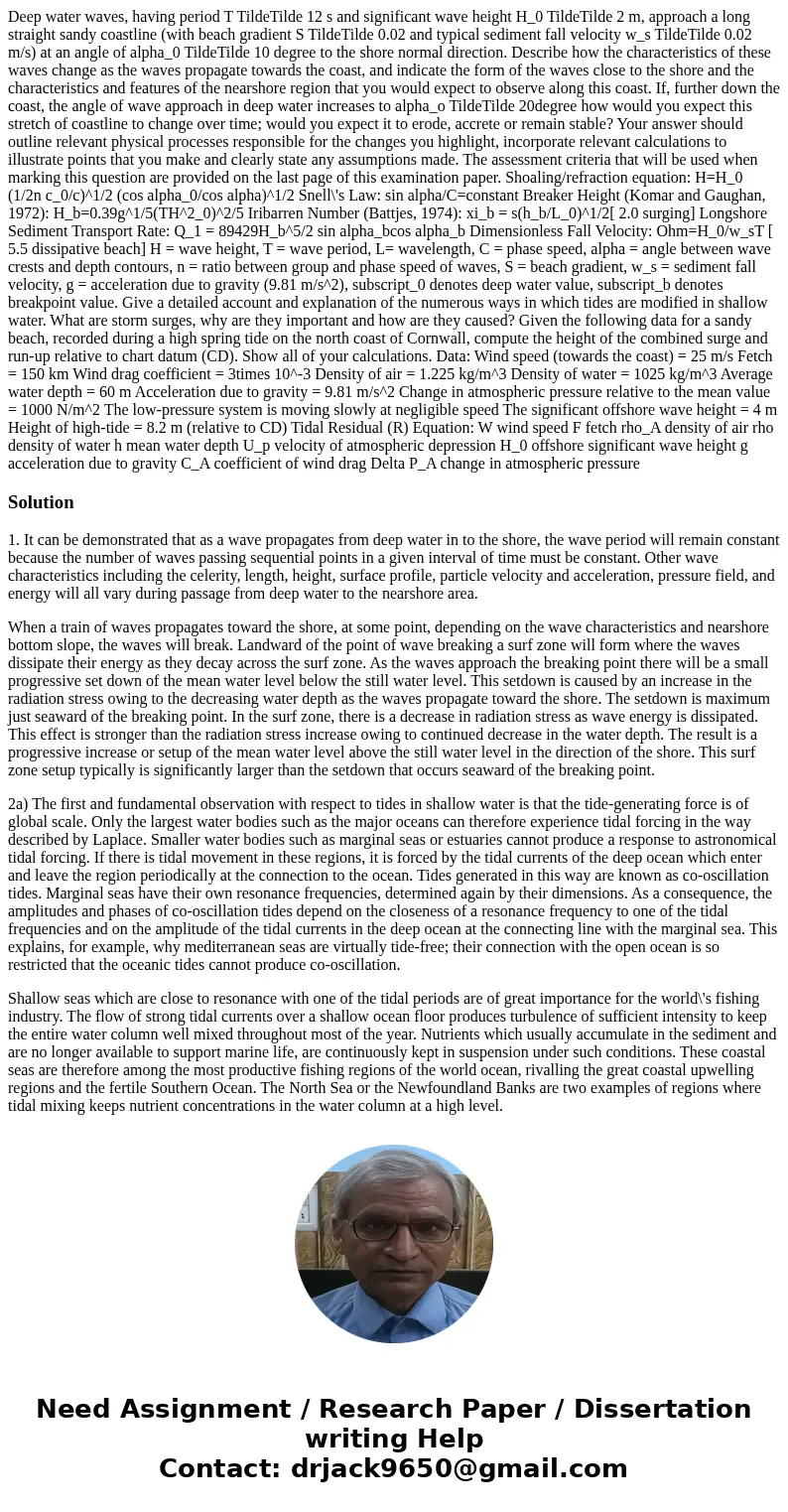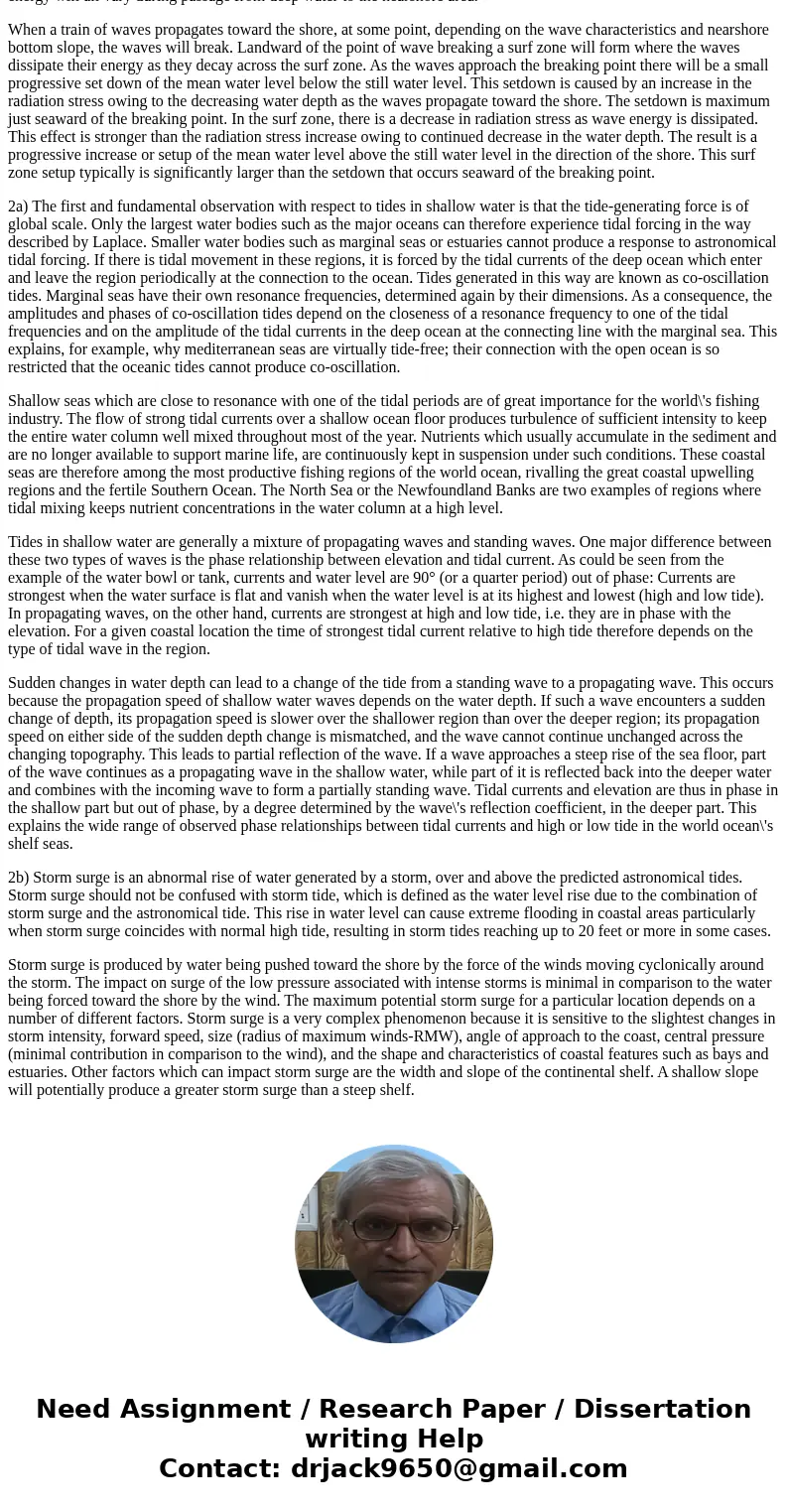Deep water waves having period T TildeTilde 12 s and signifi
Solution
1. It can be demonstrated that as a wave propagates from deep water in to the shore, the wave period will remain constant because the number of waves passing sequential points in a given interval of time must be constant. Other wave characteristics including the celerity, length, height, surface profile, particle velocity and acceleration, pressure field, and energy will all vary during passage from deep water to the nearshore area.
When a train of waves propagates toward the shore, at some point, depending on the wave characteristics and nearshore bottom slope, the waves will break. Landward of the point of wave breaking a surf zone will form where the waves dissipate their energy as they decay across the surf zone. As the waves approach the breaking point there will be a small progressive set down of the mean water level below the still water level. This setdown is caused by an increase in the radiation stress owing to the decreasing water depth as the waves propagate toward the shore. The setdown is maximum just seaward of the breaking point. In the surf zone, there is a decrease in radiation stress as wave energy is dissipated. This effect is stronger than the radiation stress increase owing to continued decrease in the water depth. The result is a progressive increase or setup of the mean water level above the still water level in the direction of the shore. This surf zone setup typically is significantly larger than the setdown that occurs seaward of the breaking point.
2a) The first and fundamental observation with respect to tides in shallow water is that the tide-generating force is of global scale. Only the largest water bodies such as the major oceans can therefore experience tidal forcing in the way described by Laplace. Smaller water bodies such as marginal seas or estuaries cannot produce a response to astronomical tidal forcing. If there is tidal movement in these regions, it is forced by the tidal currents of the deep ocean which enter and leave the region periodically at the connection to the ocean. Tides generated in this way are known as co-oscillation tides. Marginal seas have their own resonance frequencies, determined again by their dimensions. As a consequence, the amplitudes and phases of co-oscillation tides depend on the closeness of a resonance frequency to one of the tidal frequencies and on the amplitude of the tidal currents in the deep ocean at the connecting line with the marginal sea. This explains, for example, why mediterranean seas are virtually tide-free; their connection with the open ocean is so restricted that the oceanic tides cannot produce co-oscillation.
Shallow seas which are close to resonance with one of the tidal periods are of great importance for the world\'s fishing industry. The flow of strong tidal currents over a shallow ocean floor produces turbulence of sufficient intensity to keep the entire water column well mixed throughout most of the year. Nutrients which usually accumulate in the sediment and are no longer available to support marine life, are continuously kept in suspension under such conditions. These coastal seas are therefore among the most productive fishing regions of the world ocean, rivalling the great coastal upwelling regions and the fertile Southern Ocean. The North Sea or the Newfoundland Banks are two examples of regions where tidal mixing keeps nutrient concentrations in the water column at a high level.
Tides in shallow water are generally a mixture of propagating waves and standing waves. One major difference between these two types of waves is the phase relationship between elevation and tidal current. As could be seen from the example of the water bowl or tank, currents and water level are 90° (or a quarter period) out of phase: Currents are strongest when the water surface is flat and vanish when the water level is at its highest and lowest (high and low tide). In propagating waves, on the other hand, currents are strongest at high and low tide, i.e. they are in phase with the elevation. For a given coastal location the time of strongest tidal current relative to high tide therefore depends on the type of tidal wave in the region.
Sudden changes in water depth can lead to a change of the tide from a standing wave to a propagating wave. This occurs because the propagation speed of shallow water waves depends on the water depth. If such a wave encounters a sudden change of depth, its propagation speed is slower over the shallower region than over the deeper region; its propagation speed on either side of the sudden depth change is mismatched, and the wave cannot continue unchanged across the changing topography. This leads to partial reflection of the wave. If a wave approaches a steep rise of the sea floor, part of the wave continues as a propagating wave in the shallow water, while part of it is reflected back into the deeper water and combines with the incoming wave to form a partially standing wave. Tidal currents and elevation are thus in phase in the shallow part but out of phase, by a degree determined by the wave\'s reflection coefficient, in the deeper part. This explains the wide range of observed phase relationships between tidal currents and high or low tide in the world ocean\'s shelf seas.
2b) Storm surge is an abnormal rise of water generated by a storm, over and above the predicted astronomical tides. Storm surge should not be confused with storm tide, which is defined as the water level rise due to the combination of storm surge and the astronomical tide. This rise in water level can cause extreme flooding in coastal areas particularly when storm surge coincides with normal high tide, resulting in storm tides reaching up to 20 feet or more in some cases.
Storm surge is produced by water being pushed toward the shore by the force of the winds moving cyclonically around the storm. The impact on surge of the low pressure associated with intense storms is minimal in comparison to the water being forced toward the shore by the wind. The maximum potential storm surge for a particular location depends on a number of different factors. Storm surge is a very complex phenomenon because it is sensitive to the slightest changes in storm intensity, forward speed, size (radius of maximum winds-RMW), angle of approach to the coast, central pressure (minimal contribution in comparison to the wind), and the shape and characteristics of coastal features such as bays and estuaries. Other factors which can impact storm surge are the width and slope of the continental shelf. A shallow slope will potentially produce a greater storm surge than a steep shelf.


 Homework Sourse
Homework Sourse